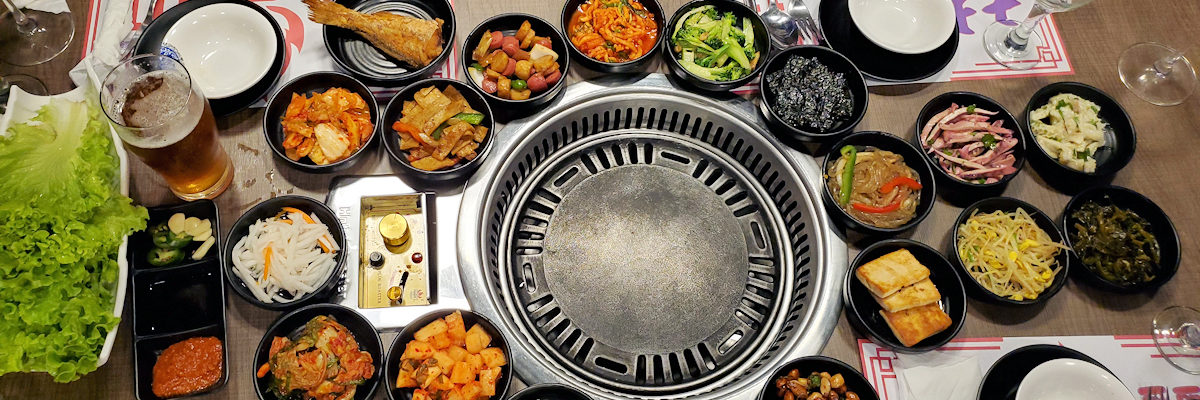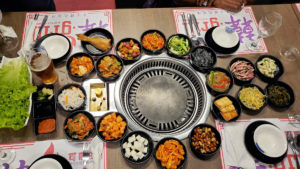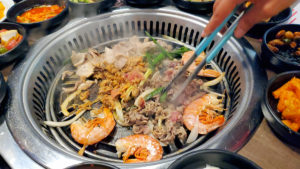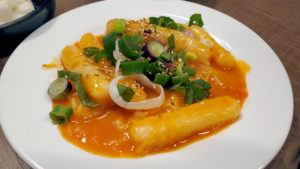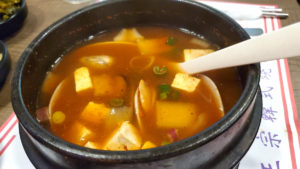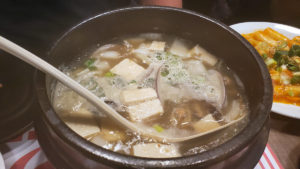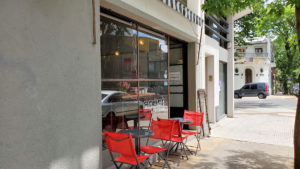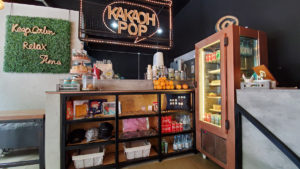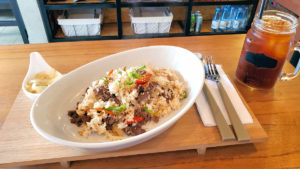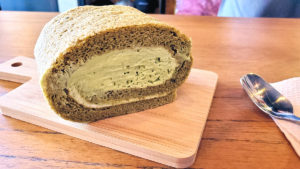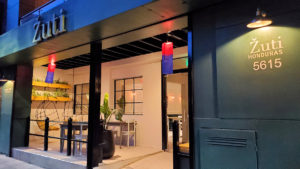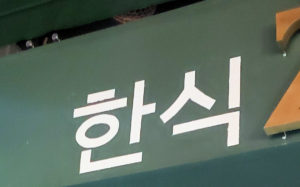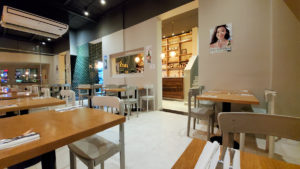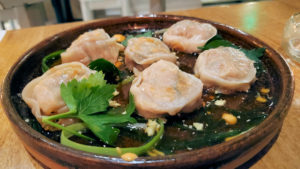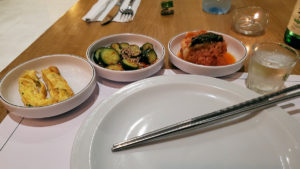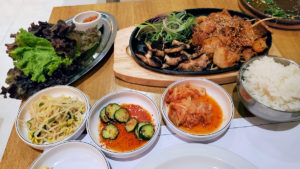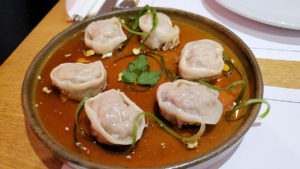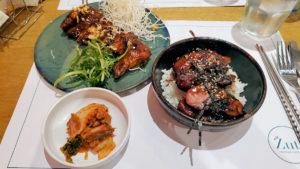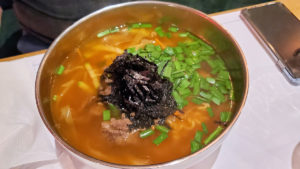I’d like to think that I’ve had something to do with the sudden popularization of Korean food in BA. It may well just be an idle conceit on my part, but, at the same time, my map of Asian restaurants on Google has over 3200 views as of right now, and my specific map of Korean restaurants on Yelp has had almost 400 views, and a whopping 5 people actually subscribed to it to keep up with changes (and Yelp isn’t even a big thing down here).
Earlier this year, I predicted the continued advance of the whole Asian Street Food trend that started to take off in 2017 and 2018, but in some ways, that seems to have fizzled out. I’m sure there must be one, but I haven’t heard about a single new opening this year, unless you count the weekly pop-up of Na Num on the night that Opio is closed. But a) that’s not a new space, it was already a space dedicated to Asian Street Food, and b) it’s specifically Korean… which leads me to today’s post, and a whopping THREE new Korean restaurants that have opened around Buenos Aires (and there are more) – and not in either of the Barrios Coreanos.
Banchan Bonanza
Taking over the spot recently vacated by the oil-infused kitchen of Tan’s Food, a place that the Horde didn’t make it to twice and I finally went on my own, is the Horde’s latest outing, K-Style Grill, Olazabal 1735 in Barrio Chino (Belgrano). A competing Korean barbecue spot to BBQ Town a couple of blocks away on Juramento, they certainly give each other a run for the money. This place definitely has the edge when it comes to variety and quantity of banchan and kimchi (with six varieties of the stuff mixed in there!). [Closed permanently during the pandemic]
One of the fun things about Korean barbecue is the whole cook it yourself schtick. Here, that’s not an option. A waiter does it for you – I can’t imagine they can do that when the place is full, but we were the only folk there, and he wouldn’t let us touch it. The meat is far more limited than the banchan selection with just slices of bacon, some beef shortrib meat, and some prawns. The latter were a bit mealy, the texture of having been deep frozen for way too long. The two red meats, however, were delicious, and we ordered another round.
I like that they include tteok-bokki, the Korean rice cakes, though the sauce was a bit bland compared to the usual.
And, two different clam and tofu soups, one “spicy” (not), and one not (also not). As best we could tell, they were identical soups other than the addition of a small amount of chili paste which did little more than color the broth.
One other big plus in addition to the banchan array – of which we could have made a meal – is a three-tap selection of craft beer. On the other hand, we haven’t been to BBQ Town in about two years, so they well may have added craft beer in too – it’s all the rage the last couple of years.
The all you can eat barbecue comes in at 950 pesos/person, plus beverages, or about $16, so figure on, with drinks and tip, around $20. Not a bad deal at all, and easier to get to for many folk than the ones in Flores or Floresta.
That’s no avocado toast
I’m trying to figure this one out. I mean, I got the part of, “hey, let’s open up a coffee shop across the street from the public medical center”. I got the, “let’s make it cute and trendy and attractive for people to come in…”.
…”with comfortable seating and kitschy decor”. And let’s call it Kakaoh Pop, El Salvador 4094, Palermo.
The part I’m still trying to wrap my brain around is the, “hey, instead of, like, the usual ham and cheese sandwiches that Argentines adore, let’s offer…
…a single Korean dish of the day…
…and trendy Japanese style pastries like a matcha cream roll.”
I mean, I’m not saying that the Bokkeum-bap (Korean fried rice) wasn’t delicious. It was. (300 pesos) And the other dishes on their Instagram feed that they rotate between don’t look equally delicious. They do. And while the tea infused pastry was tasty, if a bit under-sweetened (and that’s for me, I can’t imagine an Argentine reaction), it ain’t no dulce de leche. (150 pesos) Nor that the iced coffee wasn’t one of the better ones I’ve had in town. It was. (100 pesos)
I’m just saying, how did this little gem of a coffee shop with a total of half a dozen seats inside and another half dozen outside, serving Korean-Japanese pastries and lunch, come to be at this point in space and time?
“You keep using that word. I do not think it means what you think it means.”
So look, dude, you got punked. I’ll get back to that in a minute. This spot takes over what has been a couple of spots that never quite worked out – Basta Pablo!, Andy’s Garden – I’m not sure what it was before that. Now, it’s Zuti, Honduras 5615, Palermo – but with a hachek accent over the Z, making it a slavic Z, actually, Croatian or Bosnian in this case, and again, we’re coming back to that….
It’s not a name that screams “Korean restaurant” (well… again… give me a minute) – so they went back last week and added in the Korean characters that are an abbreviation for Korean restaurant next to it, and then did the same in red neon in the window. Not taking any chances, they want to be sure we know.
And it’s a cool space, with a nice bar, comfortable seating, and there’s a terrace upstairs. It’s all very sleek and trendy. And I’ve got the whole back story – the young man who runs the place, Brandon, does tend to share. Korean-American, he grew up in the US, moved to Argentina when he was 8, has been here since. Mom and Dad run a clothing shop in Flores, Neither they nor he have run, nor worked in, a restaurant before, though several of his friends work in or run local restaurants (like Namu and The Night Market), this is kind of a dream sequence brought to life.
To save one bit of suspense… the food is delicious. And it’s pretty. Been twice now.
There are three different kinds of dumplings on the menu – all of them are mandu, the traditional Korean dumplings, steamed, the fillings differ – kimchi, beef & vegetable, vegetable. But each is written differently on the menu – Kimchi mandu, Empandita de Carne y Verdura, Mandu de Vegetales. To me, that’s unnecessarily confusing when the only difference is the filling. they come served in lovely lacquered plates, floating in a pool of vinegar, soy, and dabs of mustard and other sauces and seeds, and stuff. It makes for a pretty presentation. And I certainly can’t complain about a lack of dipping sauce. (280 pesos) On the first visit, a bit of a complaint – the center of the kimchi dumplings was ice cold… turns out they make and freeze all their dumplings and then steam them straight from frozen. These hadn’t been in long enough and the middle had barely melted. Issue corrected, and on the second visit, piping hot through and through.
First visit, after ordering, received a trio of banchan before the dumplings – both cabbage and cucumber kimchis, and a little folded omelette. Second visit, we didn’t order a regular main course, and no banchan.
First visit, a fantastic jeokkboekkum – spicy stir fried pork, and shiitakes, to make lettuce wraps from. Served with rice, the lettuce, chili paste, and another banchan of beansprouts added to the table. They don’t quite have their timings down right (remember, they haven’t run a restaurant before) – the main course arrived while I was on my second dumpling. The waitress wanted to clear away my dumplings. No. You don’t get to take my dumplings. So she left the four plates on the next table over, for me to retrieve, because she never came back to the table. (550 pesos)
You’d think I wouldn’t go back after that, but the food was really delicious, and I can see the potential there, but I can see it as a steep learning curve for them.
So I went back with a friend on another night, and they were closed, after confirming via Facebook they were open. (Turns out that their gas had been shut off, so they just went home.) So Henry and I went back another night, after calling and getting a confirmation that they were open and there.
And, as I said, this time the dumplings, the beef ones, were piping hot. (280 pesos)
But back to that timing thing. I ordered a couple of appetizers to come out as my main course, Henry ordered a main course. Mine came out… with apologies from the waitress this time, around the time we finished the dumplings, but a solid 10 minutes or more before his main course came out. Love the chojang coated grilled sweetbreads on rice. That’s a winner right there. The Korean chicken wasn’t quite what I expected. I was thinking of the typical Korean fried chicken that we all know and love, I mean, it did say “crunchy chicken wings), this is a half dozen wing sections, not breaded and fried, so not crunchy, in sweet and salty sauce, but no spiciness. Asked for and received some chili paste, which we added to them. And, we got kimchi with these. No other banchan. (290 and 280 pesos)
Henry’s L.A. Myeon, a wordplay on the southern California roots perhaps, came out. We liked it. I can’t say we were wowed by it. It’s basically the Korean version of ramen – lamyeon (there’s that wordplay, see it now?). So much more that could be done to make that bowl more attractive. The broth was good, albeit fairly light, the noodles were decent, and there was a bit of beef and vegetables throughout. It could have just been more… arranged… like their other plates, and as ramen often is. And still no banchan. Just kind of inconsistent on that front. (400 pesos)
Okay, so finally, let’s get to the “look, dude, you got punked” part. Apparently, obviously, the whole place was “designed”. But like really designed. They worked with someone who not only designed the space, but much of the “concept”. And… the name. Because, you see, they asked the designer to come up with a name that not only had a cool sound to it, but that would communicate the concept of “Asian”, “Oriental”…. and the designer came back with the locally unrecognizable (unless you’re Croatian) word zuti… which means “Yellow“.
Just let that one sit and roll around in your woke brain for a moment. (Then again, that’s such an American reference, I’m not sure if it holds true as a racist one in other cultures.)
